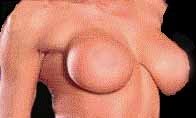When thinking of breast augmentation a consideration of the potential downside is appropriate. While untoward effects are not universal, they do occur and some can warrant further surgery. More importantly, some of your decisions about your procedure can potentially affect the likelihood that you might have a complication, namely:
- How large an implant is placed...i.e. your requested goal size.
- Whether the implant is placed over or under the pectoral muscles.
- If you have had previous breast surgery, how much scar tissue has built up and how thin your tissues are prior to another operation.
- Are your breasts quite different from one another? Might this be something you'd like improved?
Let us illustrate by example; first with generic images and then with patient images. This is presented as an educational exercise for the potential patient. Another practical reason to review these images in consideration of re-operation. As I have mentioned previously, patients have a tendency to return asking about making their implants larger. When the result of the first procedure is good (soft capsules/good symmetry), I tend to recommend holding off on re-operation. Each time an operation is performed, there is a chance for an untoward result which is usually small, but present. There are of course complications that should be addressed, such as painful or hard capsules. (If the job didn't take good judgment, then anyone could do it.) The images below were assembled at a time in which nudity could get me thrown off my former server (AOL threw me off twice). This is why many of the breasts have been edited to cover the areolae.

TOO LARGE?
The above image shows the result of very large implants placed with little soft tissue cover. In some cases, small women want very large breasts. (I have never placed implants this large) The likely outcome with such large implants is that the breasts appear "very fake." You can count on the fact that this woman will require further surgery over the course of her lifetime. Large implants like this tend to descend (or "Droop") objectionably. The implants are usually quite visible or may show Rippling (see the bottom of the page). When you read published statistics that women with breast implants frequently require more than one operation, it might be because of cases like this one. She might require five or more to get to an "OK-looking" result.
In addition, the natural tendency with an implant of this size is for the thin layer of skin and breast to contract around the implant. This can result in a firm un-natural feel as well as a breast that look like a ball. The degree to which it may happen has something to do with the patient's genetic tendency to scar and the relative lack of healthy tissue around the implant. A smaller implant will result in a much more natural-looking result with less of a tendency for contracture.

TOO DROOPY?
This image shows a young lady with two "kinda droopy" breasts. I would predict that this woman had her implants placed in the sub-glandular ("over the muscle") position. This position tends to leave the implants more noticeable. They also tend to descend more with time in this position (as opposed to sub-muscular or "under the muscle"). If she were looking to improve her appearance or make the breasts look more like one another, a breast lift would certainly be required. She may be happy with the way things are as they may have looked worse prior to surgery. Below is an example of an individual with quite large implants, which appear to just about explode out of her bikini. Again, these are implanted (little doubt) and she is more likely than not looking at more surgery in her lifetime.

TOO LARGE?

TOO THIN?
This shows the left breast from the cleavage inside aspect. Marked in cyan are several "ripples." This is uncommon. The young lady concerned came to me after having had three operations by another surgeon. These "ripples" are more likely to appear with sub-glandular placement using larger implants. Their appearance has to do with the thin cover of the patient's breast, skin and muscle allowing small wrinkles in the implant shell to be visible. Stretching the woman's tissues progressively with several operations with larger and larger implants make this more likely. Saline-filled implants lend themselves to rippling much more than those filled with silicone-gel.
Goal Size is a central issue......Those patients that complain following augmentation, most commonly complain about the "small" size of their implants post-operatively. The question often asked: "Why can't I go bigger." Rippling is one potential outcome (more commonly seen in patients with little breast tissue who wish to go fairly large) that warrants consideration into limiting the size of the implant.
The physics go something like this: Saline-filled implants due to the "thinness" of water (relative to silicone gel) can allow wrinkling at the surface of the implant. This can sometimes be seen at the surface of the skin particularly at places in which soft tissue coverage is thin or absent. Remember that in breast augmentation, the implant (even when placed "under the muscle") is only partially "submuscular" and multiple operations can progressively thin the muscle and other tissues. If soft tissue cover is thin and the implant relatively large, wrinkling may produce a visible sign. To fix this problem once it has appeared is not always easy. Changing to silicone gel implants can decrease it's incidence but ripples can still be appreciated in some of these women. The surgery has to be individualized for the patient's particular problem. Suffice it to say that it is better to work to prevent this outcome than to have to deal with it later on.
The bottom line: When thinking of your goal size, you have to consider how willing you are to have problems like rippling, implant "obviousness," breast firmness (contracture) and the need for further surgery to potentially correct these things. A modest enlargement makes these problems unlikely. This is one of the reasons I don't personally place "really large" breast implants like the some of those seen above. If you have one of these problems, you don't have to live with it (as a few of my patients have been told by their previous surgeons). There are things that can be done. It is more surgery however.
BREAST MAIN | SITE MAIN
© John Di Saia, MD... an Orange County
California Plastic Surgeon
Serving Southern California since 1997 * (949) 369-5932
|
|
|
|
Please note that this resource is offered freely to individuals considering cosmetic breast surgery. No rights are granted and it is not to be reprinted or copied without the author's prior written consent. Understand that some of the information presented may be a matter of professional opinion. Although efforts have been made to assure accuracy, no guarantees are expressed or implied.
|
|
|
|
|

